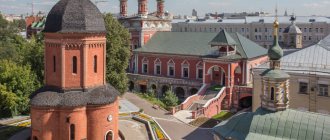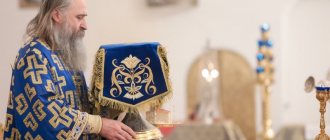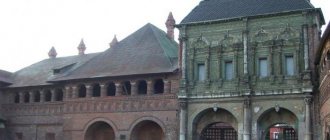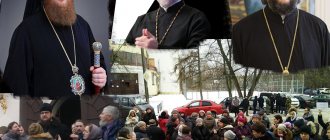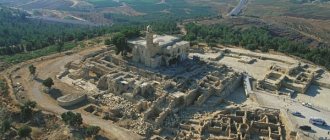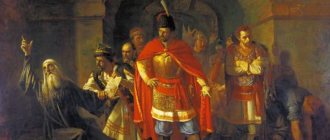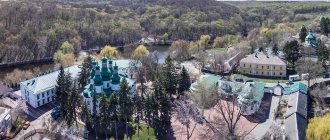History[edit]
Main article: History of the Russian Orthodox Church
The history of the Russian Orthodox Church begins with the Christianization of Kievan Rus in Kyiv, the date of which is generally considered to be 988; however, evidence for this event is disputed. In 1316, the Metropolitan of Kiev changed his see to the city of Vladimir, and in 1322 he moved again to Moscow. In 1589 the department was transformed into the Patriarchate. The patriarchate was abolished by the church reform of Peter the Great in 1721 and replaced by the Holy Ruling Synod, and the Bishop of Moscow again began to be called metropolitan. Patriarchy was restored in 1917 and suspended by the Soviet government in 1925. It was restored for the last time in 1943, during World War II, on the initiative of Soviet leader Joseph Stalin. To date, 19 metropolitans have been glorified in the Russian Orthodox Church.
Mother's vow
Patriarch Pimen, in the world Sergei Mikhailovich Izvekov , was a calm and reasonable man. And when Alexander Isaevich Solzhenitsyn wrote him letters calling on him to fight state atheism, Pimen, without any emotion, sent the messages to the trash.
Subsequently, those clergy who in the new Russia will have the opportunity to make money on alcohol and cigarettes imported duty-free will remember Pimen with pursed lips contemptuously. But the man who headed the Russian Orthodox Church for twenty years thought more about the soul and not about the budget.
Patriarch Pimen (Izvekov) (center), Archbishop of Smolensk and Kaliningrad Kirill (Gundyaev) (left in the background), Metropolitan Alexy of Leningrad and Novgorod (right in the background) and Patriarch of Jerusalem Diodorus (right) during the divine liturgy in the Epiphany Cathedral Moscow in honor of the millennium of the baptism of Rus'. Photo: RIA Novosti/Oleg Makarov.
His life was full of dizzying turns in which biographers are confused to this day. Moreover, Pimen himself did not like to talk much about the past.
Sergei Mikhailovich Izvekov was born on July 23, 1910 in the village of Kobylino, Babichevsky volost, Maloyaroslavets district, Kaluga province, into the family of mechanic Mikhail Karpovich Izvekov. However, very often Noginsk, where the Izvekov family lived, is indicated as his place of birth. Sergei's mother was a devout woman. Except for the eldest daughter Maria, all the Izvekov children died in infancy. And then Pelageya Afanasyeva made a vow: if a son is born, then his life will be devoted to serving God. So, in a sense, Seryozha’s fate was predetermined in advance.
Metropolitans of Kyiv and All Rus' (permanent residence in Moscow, 1325–1461) [Edit]
| No. | Primate | Portrait | Reign | Notes |
| 1 | St. Peter | 1308–1326 | ||
| Free seat 1326–1328 | ||||
| 2 | Saint Theognostus | 1328–1353 | ||
| 3 | Saint Alexy | 1354–1378 | ||
| Mikhail (Mityai) | 1378–1379 | Locum Tenens | ||
| Free seat 1379–1381 | ||||
| 4 | Saint Cyprian | 1381–1382 | First possession | |
| 5 | Pimen | 1382–1384 | ||
| 6 | Saint Dionysius I | 1384–1385 | ||
| Free seat 1385–1390 | ||||
| Saint Cyprian | 1390–1406 | Second term | ||
| Free seat 1406–1408 | ||||
| 7 | Saint Photius | 1408–1431 | ||
| Free seat 1431–1433 | ||||
| 8 | Gerasim ( ) | 1433–1435 | ||
| 9 | Isidore | 1436–1441 | ||
| Vacant seat 1441–1448 | ||||
| 10 | Saint Jonah | 1448–1461 | ||
Device
The ecclesiastical power of the metropolitans extended to all Russian lands, and the metropolitan diocese was also under his direct jurisdiction. At first it was the Kiev diocese itself, and then it had two parts: the Kyiv region and the region around the actual seat of the metropolitans.
At first, after the adoption of Christianity, the appointment of bishops depended entirely on the metropolitans, but in the 12th century the custom was established that the metropolitan only ordains bishops and elects them to the veche. When the appanage-veche order weakened and centralization increased, bishops began to be appointed from the capital, and the role of metropolitans in this appointment became more active, although it was often paralyzed by the power of the princes. Only Novgorod, before the loss of independence, retained the veche election of rulers, who traveled to the cathedral city only for installation. In accordance with the increase or decrease in the role of metropolitans in the appointment of bishops, his power in the dioceses increased or decreased: during the appanage period, when each diocese sought to become independent, metropolitan power was small, but with the fall of appanages it increased.
Under the metropolitan, councils of bishops of the metropolitan area were convened - at them canonical issues were resolved, rules were drawn up, and bishops were judged.
The desk documents constantly stated that the bishops should obey the metropolitan in everything, observe his duties in their diocese, appear at his first call to court or council, call him “father” - for calling the metropolitan “brother” they were reprimanded by him.
Various church incomes went to the benefit of the metropolitan: duties imposed on the installation of bishops; gifts from the newly installed and his diocese; gifts during travel; “entry” from the clergy for the maintenance of the metropolitan along with his retinue during trips. In his diocese, the Metropolitan had many estates, from which he received significant income. Like any bishop, the metropolitan received tribute from all churches in his diocese every year, Peter's and Christmas collections, collections from tithes and other servants and house people.
The court of the metropolitans was modeled after the courts of appanage princes. With him was a whole staff of free servants and people who made up a special army, under the command of a governor appointed by the metropolitan. Every free servant could freely enter the service of the metropolitan, where it was profitable to serve, since the metropolitan servants went to war only when the prince himself mounted a horse. With Vasily Dimitrievich, restrictions begin on the metropolitan’s right to accept free servants into his army, then, as the Moscow state centralizes, metropolitans are deprived of the right to have an army. To manage the metropolis, the metropolitan had secular and ecclesiastical officials: in Kyiv, for example, there were clergy governors; archpriests and archimandrites were entrusted with various judicial and administrative spiritual affairs; tithes dealt with civil litigation of church people and were in charge of collections from the clergy; Volostels were appointed to manage the patrimonial volosts.
The position of the metropolitan in ancient Rus' was very high. Being the spiritual head of all Russian lands, he stood not only at the head of the church hierarchy, but was often the closest adviser to the Grand Duke, and had an important influence on the course of state life. Thus, Saints Peter, Alexy and Jonah did a lot for the elevation of the Moscow prince; During the childhood of the blessed Demetrius of Donskoy, Saint Alexy was in fact the ruler of the state. The Metropolitan often acted as an arbitrator between the princes. Princely letters often began with the words “ with the blessing of our father, the Metropolitan
,” and were also sealed with the metropolitan signature and seal.
Device in Southwestern Rus'
With the division of metropolises, the South-Western dioceses were initially administered by the 9 dioceses listed above from the middle of the century. With the introduction of the Union of Brest, these dioceses were occupied by the Uniates, and although from 1620 Orthodox rulers were again appointed to some, in most cases they did not govern their dioceses. By the time of the Local Council of the Metropolis in 1640, there were seven dioceses operating within it: the Kiev Metropolitan proper, the archdioceses of Polotsk and Smolensk, the bishoprics of Przemysl, Lutsk, Lviv and Mogilev [4]. Since 1686, four dioceses remained under the jurisdiction of Metropolitan Gideon - Galicia, Lvov, Lutsk and Przemysl; but they too were soon converted to the union, after which Gideon remained with the metropolitan diocese itself.
In political life, in the early days of the formation of the Southwestern Metropolis, the metropolitan took a place among the highest officials of the state, but with the introduction of the union, the Orthodox metropolitan lost its importance. In the 17th century, he sought to take a seat in the Senate along with the Roman Catholic metropolitans; this was promised more than once, but was not fulfilled. Metropolitans take part in councils when choosing hetmans, and also participate in the political struggle that took place in Little Russia between the Russian and Polish parties.
With the exception of the stauropegial monasteries and the Chernigov see, the rest of the dioceses and monasteries in the field of administration were subordinate to the metropolitan, who dedicated officials there, judged, etc., sometimes appointing governors for districts, with the right to judge monasteries, churches, their parishioners and subjects on spiritual matters, and sometimes even civil ones. Since the 17th century, under the Kiev Metropolitan, a special cathedral chapter has been mentioned, according to the Roman Catholic model, consisting of the highest spiritual dignitaries of the metropolises; The metropolitan conferred with him and decided on some administrative matters. The will of Gideon (Prince Chetvertinsky) in 1690 mentions consistorists. The cathedral clergy under metropolitans and bishops was called kryloshans.
The sources of support for the Kyiv metropolitans consisted of the ownership of real estate, from court duties, fees for provision, coronal memorials, as well as various fees: canteens - two kopecks from each courtyard, world fees - by money, malt fees - by half a ruble, office fees - by money . The immovable estates of the Kyiv department were formed mainly through grants from state authorities, hetmans and Kyiv colonels; private individuals also donated a lot; The department itself acquired a lot of land by purchase.
Metropolitans of Moscow and All Rus' (1461–1589) [edit]
| No. | Primate | Portrait | Reign | Notes |
| 1 | Theodosius | 1461–1464 | ||
| 2 | Philip I | 1464–1473 | ||
| 3 | Gerontius | 1473–1489 | ||
| 4 | Zosim | 1490–1494 | ||
| 5 | Simon | 1495–1511 | ||
| 6 | Varlaam | 1511–1521 | ||
| 7 | Daniel | 1522–1539 | ||
| 8 | Joasaph | 1539–1542 | ||
| 9 | Saint Macarius | 1542–1563 | ||
| 10 | Afanasy | 1564–1566 | ||
| 11 | Saint Herman | 1566 | ||
| 12 | Saint Philip II | 1566–1568 | ||
| 13 | Kirill III (IV) | 1568–1572 | ||
| 14 | Anthony | 1572–1581 | ||
| 15 | Dionysius II | 1581–1587 | ||
| 16 | Saint Job | 1587–1589 | Elevated to the rank of Patriarch |
Patriarchs of Moscow and All Rus' (1589–1721) [edit]
| No. | Primate | Portrait | Reign | Notes |
| 1 | Saint Job | 1589–1605 | ||
| Ignatius | 1605–1606 | |||
| 2 | Saint Hermogenes | 1606–1612 | ||
| Vacant seat 1612–1619 | ||||
| 3 | Filaret | 1619–1633 | ||
| 4 | Joasaph I | 1634–1640 | ||
| Vacant seat 1640–1642 | ||||
| 5 | Joseph | 1642–1652 | ||
| 6 | Nikon | 1652–1658 | ||
| Pitirim | 1658–1667 | First possession; locum tenens | ||
| 7 | Joasaph II | 1667–1672 | ||
| 8 | Pitirim | 1672–1673 | Second term | |
| 9 | Joachim | 1674–1690 | ||
| 10 | Adrian | 1690–1700 | ||
| Stephen | 1700–1721 | Locum Tenens | ||
Metropolitans and archbishops of Moscow (1721–1917)[edit]
| No. | Primate | Portrait | Reign | Notes |
| 1 | Stephen | 1721–1722 | ||
| 2 | Feofan | 1722–1736 | ||
| Vacant seat 1736–1742 | ||||
| 3 | Joseph | 1742–1745 | [1] | |
| 4 | Plato I | 1745–1754 | [2] | |
| Hilarion | 1754–1757 | Coadjutor | ||
| 5 | Timothy | 1757–1767 | ||
| 6 | Ambrose | 1768–1771 | ||
| Samoel | 1771–1775 | Coadjutor | ||
| 7 | Plato II | 1775–1812 | ||
| 8 | Augustine | 1812–1819 | ||
| 9 | Seraphim | 1819–1821 | ||
| 10 | Saint Philaret | 1821–1867 | ||
| 11 | Saint Innocent | 1868–1879 | ||
| 12 | Macarius I | 1879–1882 | ||
| 13 | Ioannikiy | 1882–1891 | ||
| 14 | Leonty | 1891–1893 | ||
| 15 | Sergius I | 1893–1898 | ||
| 16 | Saint Vladimir | 1898–1912 | ||
| 17 | Saint Macarius II | 1912–1917 | ||
Patriarchs of Moscow and All Rus' (restored, 1917–present) [edit]
| No. | Primate | Portrait | Elections | Reign | Notes | |
| 11 | Saint Tikhon | 1917–18 | December 4, 1917 | April 7, 1925 | ||
| Seat vacant 1925–1943 |
| |||||
| 12 | Sergius I | 1943 | September 12, 1943 | May 15, 1944 | ||
| 13 | Alexy I | 1945 | February 4, 1945 | April 17, 1970 | ||
| 14 | Pimen I | 1971 | June 3, 1971 | May 3, 1990 | ||
| 15 | Alexy II | 1990 | June 10, 1990 | December 5, 2008 | ||
| 16 | Kirill I | 2009 | February 1, 2009 | Active | ||
Canal Army soldier, sanitary inspector, head teacher
In 1937, during the “Great Terror”, Pimen was arrested again and sent to forced labor on the construction of the Moscow-Volga canal. For many, the end of construction became the day of liberation, but Pimen was among those who were assigned a new place to serve his sentence: Uzbekistan. In Andijan they appreciated the good education that the disgraced monk had, and soon Comrade Izvekov became a sanitary inspector for the quality of public catering. A little later, he was appointed head of the regional House of Health Education, thanks to which he was again able to visit Moscow, where he went to a conference of health education workers.
In 1940, Sergei Izvekov entered the literary department of the Andijan Evening Pedagogical Institute. From health education he moved to regular education, becoming the head teacher of school No. 1 in Andijan. Perhaps Izvekov would gradually become an honored teacher, but the beginning of the Great Patriotic War again changed his fate. In August 1941 he was called up for service.
